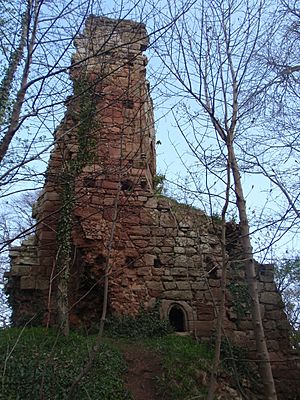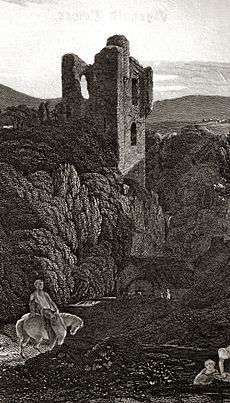Yester Castle facts for kids
Yester Castle is a very old castle that is now mostly in ruins. You can find it about 2.4 kilometers (1.5 miles) southeast of a village called Gifford in East Lothian, Scotland. The only part of the castle that is still complete is a secret underground room known as the Goblin Ha' or Hobgoblin Ha' (which means Goblin Hall). This castle is so important that it's protected as a Scheduled Ancient Monument. This means it's a special historical site.
Contents
The Castle's Story
Yester Castle was first called Yestred. This name comes from an old language called Brythonic, and it means a wide valley or dale. King William the Lion gave the land of Yester to a man named Hugo de Giffard. Hugo was a Norman, which means he came from a region in France called Normandy. He received this land in East Lothian during the time of King David I of Scotland.
Building the Castle
The first stone tower, called a keep, was built before 1267. Many people believe it was built by Sir Hugo de Giffard. He was the grandson of the first owner of Yester. Sir Hugo was also a guardian for the young King Alexander III of Scotland. People even said he was a magician! King Alexander III visited Yester Castle around May 1278. He even wrote letters to King Edward I of England from there. After the Wars of Scottish Independence, Yester Castle was rebuilt with strong outer walls.
Battles and Changes
In 1298, during the Battle of Falkirk, a knight named Alexander de Welles was killed. Another man, Adam de Welle, was also there. King Edward I of England, who was in charge of Scotland at the time, gave Adam de Welle some land that had been taken from Scottish nobles.
Later, in 1357, the Giffard family no longer had any sons to inherit the castle. So, Joanna, a daughter of the last Sir Hugo de Giffard, married Sir William de la Haye. Through his wife, Sir William became the owner of Yester. The Hay family has owned the land ever since.
In 1487, David Hay of Yester became the first Lord Hay of Yester. This was a special title given by the King. In 1513, a terrible battle called the Battle of Flodden happened. John, the second Lord Hay, was killed there, along with many other Scottish fighters.
Attacks and New Homes
In May 1544, during a conflict known as the Rough Wooing, the English army burned the castle, the nearby village, and the crops. This happened when they were returning from burning Edinburgh. John, the fourth Lord Hay, bravely defended the castle from an English force in 1547. However, he was captured later that year at the Battle of Pinkie and held in the Tower of London for three years. In February 1548, an English commander captured Yester Castle and put another Scottish noble in charge.
By 1557, the fourth Lord Hay had passed away. His son, also named John, decided to leave the old castle. He moved into a new, stronger house built where the grand Yester House stands today. The old castle slowly fell apart. People even took stones from it to build other things. But the original Goblin Ha' was still used! The Marquess's falconer lived there until 1737. The newer Yester House was sold in 1972 to a composer and then sold again in 2013.
The Wizard of Yester
Sir Hugo de Giffard was known as the 'Wizard of Yester'. People believed he was a very powerful warlock or sorcerer. They thought he practiced his magic in the underground part of the castle, the Goblin Ha'. A writer from the 15th century, Walter Bower, wrote about the large cave at Yester Castle. People believed it was made by magic! Legend says that Hugo made a deal with the Devil to get a magical army to help him. This army of hobgoblins was supposedly the one that built Yester Castle.
The Colstoun Pear
Sir Hugo de Giffard had a daughter named Margaret. When she was going to marry a man from the Broun of Colstoun family, Sir Hugo gave them a special pear. He warned them that if anything ever happened to this pear, bad luck would come to the Broun family. The pear was kept safe in a silver box, and the Broun family did very well for many years.
However, hundreds of years later, in 1692, something happened. On her wedding night, the fiancée of Sir George Broun (who now owned the Colstoun estate) took the pear out of its box. The fruit looked as fresh as the day it was picked, and she couldn't resist taking a bite.
Soon after, bad things started to happen. Sir George Broun lost a lot of money gambling and had to sell his estate to his brother Robert. Not long after, Robert and his two sons were killed on their way to Edinburgh. They were swept away by a sudden flood from the River Tyne. Sir George died in 1718 without any sons to inherit his name. People say that after the pear was bitten, it turned as hard as a rock. You can still see the bite mark on it at Colstoun House today!
|




